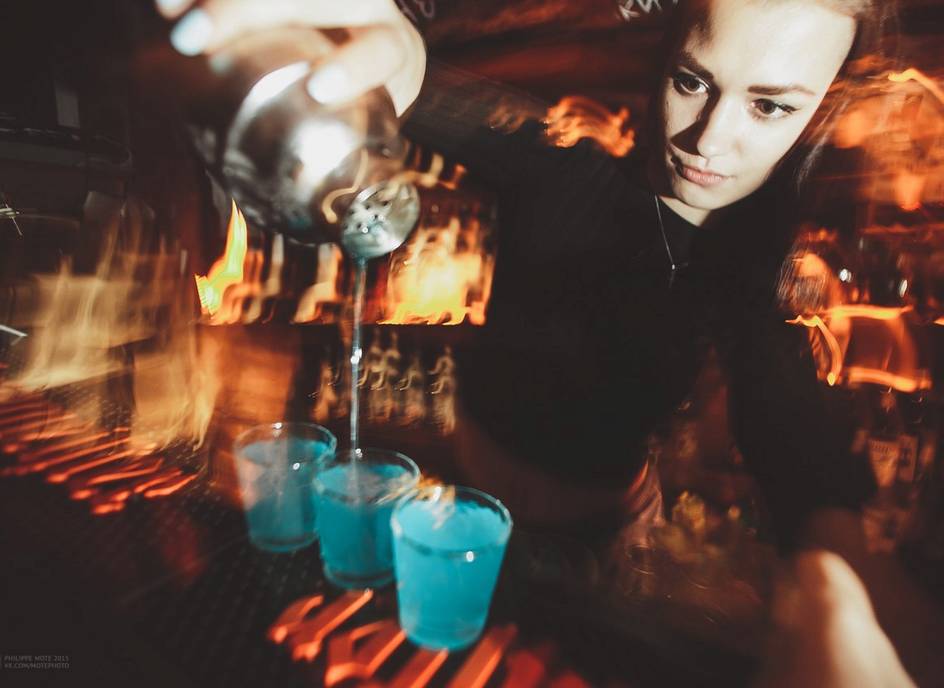
Don’t worry - we didn’t wake up on a barge! But it was an unusual place – the flat of Kostya Kreutz - one of the most fashionable establishments in St. Petersburg nowadays. Is it either a restaurant, or a time-cafe, or a coworking centre - overall it is absolutely multifunctional and very interesting. You can even spend the nigh in a large and very stylish bedroom, located right in the next room. After all, we should not forget that this is a real apartment on the Nevsky Prospekt - the most expensive one in the city. The cost of a night in the airbnb is 380 thousand rubles. Its owner is Kostya Kreutz who says he was inspired by the Parisian private club Silencio that belongs to David Lynch. Yes, the “behind the scenes” atmosphere reigns throughout: in order to get in you must first get the virtual keys on the apartment’s site (kind of like registering).

By the way, everyone is asking, who is this mysterious Kostya Kreutz. No, he was not an experienced restaurateur and he isn’t a part of the golden youth; he is a completely non-public persona engaged in some serious real estate. He is the cardinal of the city’s dandies and snobs.

When we arrived to the city-port and city-fortress of Kronstadt, the sun came out and the first snow started falling. And, as it always is in St. Petersburg, both events happened almost simultaneously. It was cold, and the island of Kotlin, a city lapped by the black waters of the Gulf of Finland, seemed even more impregnable.

In fact, it is a unique place – 41 round-the-globe voyages started right here! We thought this fact was very romantic and exciting.
The only way to get here was by sailing - that was until 1983 when the road that connected the island to the "mainland" was built. Then, until 1996, the city remained closed to ordinary people, and to get in one needed a special pass. And now Kronstadt is under UNESCO protection and is open to all visitors.
The first fort (a total of 21, not counting the Kotlin) was built in the beginning of the 18th century, in just one winter, so the Swedish were really surprised to see it on their pass to Nevsky Lip. The place was really successful: no enemy ship has ever made it pass Kronstadt. The castle burned almost to the ground, suffering from devastating floods, rebellions and war. Despite the fact that the island of Kotlin was in the vicinity of St. Petersburg during World War II, it never gave in to the enemy and held up until the Russian victory. The Oranienbaum - Kronstadt - Lisy Nos route has been since called the “smaller road of life."

It’s a truly majestic building, and somewhat particularly thoughtful looking.
The cathedral stands on the Anchor Square, where they used to keep old anchors. The laying of the walls took place in 1903 in the presence of Emperor Nicholay II. Everything here feels grand and steadfast. Inside one of the galleries there are 130 memorial plaques of black marble with the names of the dead sailors and 20 boards in white marble with the names of the priests. And all the carpets in the cathedral were embroidered by the wives of sailors.

February 14, 1930 all the church bells and all the crosses were removed from the cathedral. It was later converted into a cinema named after Maxim Gorky, after which the locals called it simply "Maxim".
Fortunately, at the beginning of the 21st century the cathedral was returned its higher purpose and status.

Deciding to take a short break from all the water, we went to a place that was highly recommended by all of our friends from St. Petersburg - Russia's only official museum of street art.

This is not just a museum but a cluster of fashion and art. It appeared here almost spontaneously after a graffiti party was held in one of the abandoned shops back in 2011. There still prevails a sort of "lawlessness" here: artists can paint on every visible surface; the public wonders through the darkest nooks and crannies of the plant, and on weekends DJs perform in abandoned halls. The museum also operates as place for an excellent educational programme - you can come and listen to a lecture about the urban transformation, or the cheeky aspect of street art.

The next cultural stop on our "water" route. To be honest, we did not expect this place to be something special, but we were wrong. We’ve never seen such beautiful traditional Russian interiors and intricate architecture.

A little about this institution. In 1876, Baron Alexander Stieglitz has allocated 1 million rubles for the construction of the School of Technical Drawing "for both sexes." With such a generous gesture was born one of the most influential artistic schools of the country. Interestingly, the author of the project was the first director of the School - the architect Maximilian Messmacher - and almost all the finishing work on the interior decoration was made by local students and teachers. One of the most beautiful rooms is called "Terem" and it is fully painted in the Old Russian traditions.
There is also a museum of applied arts, the main value of which lies in the fact that:
a) it is situated in marvelously luxurious historical interiors; b) walking through its halls, you can inadvertently peek at how students draw, or sit in interesting lectures on art history.
By the way, the locals commonly refer to it as the Academy of "The Fly” (‘Mukha’). Why? Because, for almost the entire second half of the 20th century the Academy ‘wore’ the name of Vera Mukhina (Mukha=fly). Only in 1994, the institute’s name was finally restored.

When we first visited this church, Natasha fainted in the truest sense of the word. The fabulous facade pales in comparison with the mosaics inside. This place is in the top 25 most "coveted" tourist sites in the world. No other Russian monument made this list, and that says a lot.
The temple was built on the site where Tsar Alexander II was fatally wounded. There were 5 other attempts before, and the sixth one was successful. In order to build the church on “the spilled blood”, the authorities had to complete the construction of the embankment first.

Of course, such a grim story produced hundreds of urban legends. Immediately after the consecration of the cathedral people began to say that under its arches you can hear the moans of the deceased emperor. There is also a mysticism of numbers. For example, the central temple has a height of 81 meters, which corresponds to the year of death of Alexander II, and the second highest dome rises to 63 meters, as the emperor died at the age of 63!
In the late 1930s, the Soviet authorities decided to blow up the temple as a meaningless object, devoid of any artistic value. The walls were filled with explosives when the Great Patriotic War started, and the demolishers had more urgent work to do. In Soviet times, the cathedral was the Dzerzhinsky district morgue, the air-raid shelter and even a vegetable storage!
The temple was under construction for 14 long years since 1977. Its walls were tightly sealed the whole time. The progress was very slow, and it often came to a complete stop. They began to say that as soon as it’s done so will be the Soviet Union. That is exactly what happened - in 1991. This is what is called a place of power!

It was the first time we saw the bridges being separated. It seems like nothing special at first. However, when you are there, seeing it happen, it is truly magical. We were spellbound seeing this heavy, immovable stone slabs gradually diverge in the middle. We even forgot we had to shoot.
If the bridge could get into show business, it would become the biggest star. The toughest bridge in the world has surely seen its fair share of drama in the last century! It was fired at, decorated and redecorated, almost demolished and then rebuilt, it became a scene for grandiose ideas, and even transformed into an open-air cinema.
Before it officially opened for the citizens, it was decided to test its strength - 34 trucks loaded with 600 pounds (9600 kg) each at the same time entered the bridge and occupied all the spans. The construction stood without flinching. So, December 23, 1916 the first carrier officially passed to the other side.
Because of the war, the bridge remained almost "naked", without any frills, and all the basic decor was made during the Soviet era in the 30's.

In 1997, the government decided to remove the tram tracks and make the bridge more of a spectacle, adding 28 lamps.
The bridge is separated almost 300 times a year. It all lasts exactly five minutes, but believe me, it will be the most unforgettable five minutes of your life!













